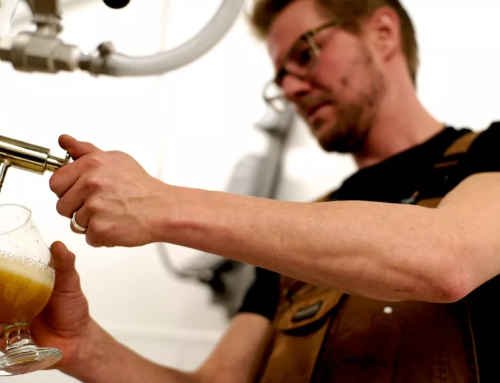Capping your mead

Are you planning to age your mead?
You have taken the very good decision to cork your mead, rather than cap it.
Bottle tops are perfectly acceptable for sparkling meads made as part of so-called 'health' drinks, but that's about it.
Especially not the capsules for making wines intended to delight delicate palates!

The corking of your bottle is the final step in the long journey of making mead, and all your hard work deserves a cork that reflects the quality of your brewing, don't you think?
Although it doesn't add anything to the taste (hopefully), a good cork adds a manly touch to the presentation of your bottle, and most importantly, it keeps the final container of mead airtight (in fact, almost airtight - which is a good thing - but more on that later).
Here's what you need to know about corks and corking your mead, starting with the following questions: What is cork?
OK, here's the cork story!

Cork comes from the phellenic layer of the bark of the cork tree (Quercus Suber), which is the secondary, softer layer of bark, just behind the hard outer layer.
Part of the oak genus, the cork oak has developed this layer to protect itself from periodic forest fires in its native Mediterranean habitat in Western Europe and North Africa.
Most cork trees are harvested when they are 25 years old, then every 9 years thereafter.
If debarked correctly, the tree is little affected by the removal of the bark, making the process sustainable.
Although the trees are becoming more susceptible to fire, many exploited cork forests, particularly in Portugal and Spain (where around 80 % of the world's cork comes from), have attained the status of old-growth forest, becoming a refuge for plants and animals found nowhere else in the world.
Most cork trees live up to 130 years, with some reaching 300 years or more!
Why cork is ideal for ageing a bottle of mead
The bark layer of cork has an elastic, sponge-like property that is completely permeable to liquids, but porous enough to allow a small amount of air to pass through over time.
These unique properties make it perfect for ageing wines, meads and beers with a high alcohol content, as this limited air transfer is actually necessary to age the contents gracefully over time.
Too much air can cause excessive oxidation (you know the taste), and too little - or no air - limits the ageing process.
How is cork made?

Once the cork bark has been harvested from the tree, it goes through a specific manufacturing process, the basic stages of which have changed little over the centuries:
1) The cork is bundled and boiled. The added moisture flattens the cork bark and makes it easier to work.
2) The cork bark is placed on a flat, dry, clean surface for 3 to 6 months. "Clean" is the key word here in order to limit any contamination or bacteria.
3) The cork packages are cut into strips according to the length and width requirements of the cork (they make all kinds!).
4) The strips are sent to workers or machines that cut the cork into shapes. The offcuts and by-products are then processed into cheaper corks called agglomerated, corked or technical corks.
5) The natural corks are then mechanically separated by the porosity of the air.
6) The corks are then separated into categories by skilled workers.
7) The cap is vacuum-sealed and prepared for shipment.
Here is an excellent video of the treatment process used by the Amorim Cork Company in Portugal:
The history of the cork as a bottle closure
With its classic look and function, you might think that cork has been the stopper of choice for as long as people have been drinking mead, but you'd be wrong. Before cork became the standard bottle closure, all sorts of other methods were used to stopper a mead bottle, including leather, beeswax, clay and even oil-soaked cloth.
Non-standard shaped containers
Although cork has been known for its watertight properties since Ancient Greece, the problem was not the cork, but rather the containers holding the liquids.
Whether clay, glass, pewter or other materials were used, the manufacturing processes for these containers were not uniform, which meant that a uniform surface could never be obtained so that a stopper such as cork could seal the container reliably.
The best bottle makers used to make their corks by hand with each bottle to create the best possible seal.
As you can imagine, this made the manufacture of bottles very expensive, and therefore accessible only to the wealthiest customers.

Making good glass
What mead lovers really needed to age their quality meads, they got in the form of English businessman George Ravenscroft, who developed a method for using lead in the glass-making process on an industrial scale.
The lead stabilises the molten glass, allowing it to be handled for longer periods of time and to be formed on templates.
All of a sudden, the bottles produced had a constant neck size.
French winegrowers were among the first to notice that wine bottles corked with cork had the ability to age and develop in the bottle.
Legend has it that the French monk Dom Pérignon (circa 1670) was one of the first to discover that natural cork was superior to corking wine with a cloth. Thanks to this new discovery, the French were able to create first-class aged wine brands that have stood the test of time.

Cork: The stopper of choice
"YOU CAN'T BEAT NATURAL CORK".
Fast forward 300 years and natural cork is still used in the majority of wine corks - between 65 and 70 % of all bottles sold today. Although there are no official figures for the use of cork by mead makers, we believe the figures are similar as the mead fermentation process is closely linked to that of wine.
Cork quality
As natural corks come from a natural source, they will have imperfections.
It can also be susceptible to pathogens such as bacteria and mould. When assessing the quality of cork, mead-makers look at two criteria:
1) Air permeability
2) The presence of contaminants (in particular trichloroanisole or TCA).
Let's look at each of these criteria individually:
Air permeability
Mead, like wine, needs the right amount of oxygen and nitrogen to age gracefully in the bottle.
Too little, and unwanted by-products of the fermentation process, tannins or brewing additives (sulphites) remain untreated.
If there is too much, excessive oxidation will occur.
Both scenarios can compromise the quality of your mead in different ways.
How?
In general, over-oxidised mead will develop a ripe fruit and/or nutty smell and taste, while anaerobic conditions (i.e. the absence of oxygen) can give your mead faded colours, pungent smells and a bitter taste.
Creating the perfect conditions
To create the ideal conditions in your mead bottle, you need to buy a cork that lets the right amount of air into the bottle each year.
What is the ideal amount of air permeability? For a typical filled bottle of wine or mead, this represents around 1 milligram of air per year.
Needless to say, it's not much air.
You're probably wondering, "How can I test the gas permeability of a milligram through a cork?"
The answer is: you can't.
Here is a classification of the uses of corks in France. This will give you a good idea of the cork that will meet all your needs.
- Vin de France VSIG (wine without geographical indication), e.g. Table wine: stopper 38 mm long and 24 mm in diameter.
- PGI(Protected Geographical Indication), ex Vins de pays: cork 44 mm long and 24 mm in diameter.
- AOC/AOP 54 mm diameter cap
- Champagne 47 mm long and 31 mm in diameter.
It is estimated that top-quality closures allow around 1 mg of air to pass through at room temperature, while lower-quality closures can allow much more.
TCA contamination
Over the past 20 years, cork has struggled to defend its excellent reputation as the cork of choice for aging fine beverages.
Before 2000, cork was the undisputed choice as a stopper, accounting for well over 95% of all bottled wines, today it hovers around 65-70%.
Why did it fall?
Three letters to watch out for: T - C - A
Short for trichloroanisole, TCA is a chemical substance produced when naturally occurring fungi, moulds or bacteria react with chemicals called chlorophenols.
Chlorophenols are present in many modern herbicides, pesticides and cleaners and can find their way into a cork plant or wine cellar through a number of insidious routes.
Once present, these cholorphenols can be extremely difficult to remove.
In the early 2000s, TCA contamination was such a significant problem that it was suspected that around 5 % of all wines had a corky taste.
Today, thanks to a concerted effort by the entire sector, this figure has been reduced to around 1 % of all wines sold.
Despite these improvements, the reputation of cork stoppers was tarnished, allowing competition in the form of synthetic stoppers, screw caps and even boxes (surprise!) to become an accepted method of aging wine despite their limitations.
What does TCA smell like?
For us, a clogged bottle smells a bit like when our dog decides to swim in a holding tank, and we forget to wash him for a few days.
For a more scientific description, here is a good table we found online that shows the olfactory profile of TCA as a function of contamination levels.
Note that the measurement is in nanograms per litre or 1 nanogram = 1 billionth of a gram.
All this to say that TCA is an extremely powerful smell!
With all the concerns about contamination, many craft brewers swear by boiling their corks to ensure a certain extra hygiene.
We do not do this and we advise against it.
Boiling the cork will not disinfect it any more than the cork manufacturer has done, and it may even weaken the cork at the cellular level.
To ensure the cleanest caps:
Keep them in their original packaging for as long as possible.
If you have any left after opening the bag, store the rest in vacuum-sealed bags once they have been opened.
Buy from a reputable manufacturer.
Home brewers may find it difficult to find quality cork, as we do not have the volumes of the large manufacturers.
However, if you look hard enough on the internet you can find producers in Portugal who will supply you directly for small quantities.
Buy cork for your mead
You can buy cork just about anywhere online, or from your local brewer, and prices range from a few cents per cork to a few euros.
They exist in an astonishing proliferation of styles, forms and qualities.
So which one is right for you?
Define your needs
For all our cork snobbery, finding the right cork really depends on what you're looking for.
If you want to open your mead soon after bottling, use a screw cap or a cheaper cork stopper.
However, for those who wish to age their mead for a year or more, we suggest you spend a little more on quality corks from a reputable buyer.
Size considerations
Most mead brewers use standard-sized wine bottles to hold their mead.
If you plan to do the same, you will want to buy a straight cork stopper that is the right size for your containers.
As a general rule, the longer the cork, the longer your mead will last.
Where to buy
There are many manufacturers, but as we mentioned earlier, you can try your hand at a famous manufacturer in Portugal at Laffite Cork if you buy in large quantities, otherwise on the internet at Core of the cork or high quality products prepared in Gironde here at Ducasse Buzet.
Ducasse selects a wide range of corks and sells them to private individuals, which is an excellent choice if you plan to age your mead for more than 4 years.
Capping your mead
Corking day is a celebration! It's the culmination of all the hard work you've put into your mead.
With a bit of luck, the operation should be quick, painless and successful.
However, unless you have the strength of Odin, you can't simply plunge the cork into your bottle with your thumb.
Corking your mead requires a little mechanical assistance, in the form of a corkscrew.
Although there are many different styles of corkers on the market today, they all fall into two main categories: hand-held corkers and floor or bench-mounted corkers.
Let's take a look at each of them:
Hand-held corkers :
Hand-held plugs are less expensive than floor plugs, but require a little more finesse, practice and effort to use.
Hand caps are a good economic choice for mead producers who plan to produce less than 25 litres (~30 bottles) of mead a year.
It takes a little getting used to, so don't be frustrated if you end up with a broken bottle or two or a cork stuck halfway down the neck while you're learning the nuances of the tool.
Dip your cork
Because of the limited torque of manual corks, you will need to use a lubricant (organic beeswax) to ensure that the cork is correctly positioned in the bottle.

We start with the piston capper: Plastic piston cappers, the cheapest of the lot, use brute force and no mechanical leverage to get the cork into the bottle.
You will certainly need another person to stabilise the bottle, while someone else will use their body weight or a rubber mallet to push the cork into the bottle.
Caution, is used mainly with small diameter caps.
Also, as mentioned above, be sure to soak your corks beforehand.

Double lever metal stopper: For a few euros more, get a lever and buy a double level stopper. With the extra torque, you can use the 45 x 24 mm plugs we recommend.
It takes some practice to centre the plunger and you need to soak the plug.

Gilda Handheld Compression Capper: For a handheld capper, the Gilda capper is the closest to the floor capper in its operation.
This is a two-stage operation; the first stage compresses the cork as you pull the red handles together.
The second step is to plunge the compressed cork into the bottle.
Most appliances are equipped with a plug depth adjuster.
Although it gives you greater strength when applying the cork, it's still a little unstable.
We therefore recommend that you use another person to stabilise the bottle during the second phase.
Floor and table top corkers
Table and floor stoppers are by far the easiest to use, offering the best leverage and allowing you to get away with it comfortably with one person.
What we like best is that we don't need to soak or steam our corks.
Recommended for anyone making 40 litres (~50 bottles) or more of mead a year.
NOTE: Floor caps must be engaged quickly. If you pull the levers too slowly, the cap will decompress too soon, leaving some of the cap sticking out of the bottle.

Portuguese floor corker
Excellent value for money, to use it simply place your cork on the top compression area and centre the plunger, then place your bottle on the black base. Finally, quickly pull the lever and, viola!
It's not very big, so be prepared to kneel down a little for the corking.
Most have mounting holes on the base, and I've heard of people bolting them to a table, but in this case they might be TOO big for an average sized person to pull the lever.

Italian floor plug
A larger version of the "Portuguese" floor plug, the Italian model is larger and offers more leverage on the handle.
It is much easier on the back, but you still have to bend a little to place the bottle and cap in the device.

Benchtop corkers
Our favourite ergonomic corker, it is ideal for mounting on a workbench or table.
Although it's the most expensive of the lot, it's a must for us if we're making 50 bottles or more at a time.
It saves us space and saves our backs from being bent over a little floor filler all that time.
Ours has mounting holes to stabilise the unit on the table and an adjustment to set the depth.










We should do a course on corks and bottle stoppers. The old-fashioned way while we're at it.
Hello Georges, this could indeed be the subject of a future training course. Sincerely